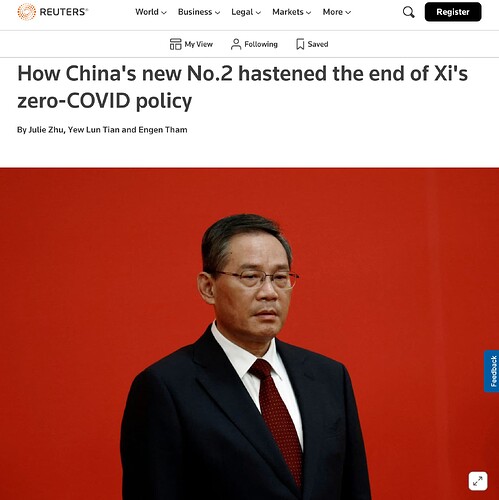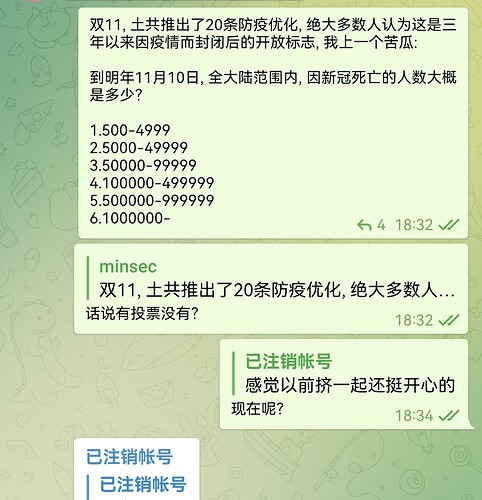-
李强最近被提升为执政的共产党政治局常委中的第二号人物,他推动了比原计划更早启动重新开放计划的决定,以控制新冠清零运动和抗议活动造成的经济损失,这些抗议活动曾使领导层感到震惊。
-
中国政府没有公开解释其在新冠清零问题上转弯的决策过程。
-
路透社在与6名以上了解讨论情况的人交谈后,收集了一份关于中国重新开放道路的说明。
-
结果是12月的混乱的重新开放,当时中国突然结束了封锁、大规模测试和其他限制。
-
之前没有报道的细节为了解中国高层官员和医疗专家之间的讨论提供了一个罕见的窗口,包括李强和习近平之间关于重新开放的步伐的分歧。
-
由于话题的敏感性,或者因为他们没有被授权与媒体交谈,这些人在匿名的情况下发言。
-
11月的抗议活动标志着习近平在处理新冠疫情管理方面的一个转折点,因为他开始采取不那么亲力亲为的方式,允许他的长期盟友李强负责。
-
最高领导人最终选择了匆忙重开,以安抚年轻的抗议者,因为持异议者可能对政权的稳定构成的威胁被认为比允许病毒不受控制地传播更具政治风险。
-
2020年10月,中国官员开会讨论如何解除中国领导人习近平实施的严格的新冠清零政策。党中央新冠清零工作组副组长王沪宁领导了这次会议,并要求与会者以不同的速度制定各种重新开放的路线图。国家卫生委员会提出了全面重新开放的基准,其中关键是提高老年人的疫苗接种率。
-
由于缺乏检测公司和安保公司的资金,地方一级的党务工作者和医疗卫生官员在执行零接种政策时很吃力。北京某分区的一位地方领导报告说,他们无法执行这一政策。北京地方政府去年在COVID预防和控制上花费了近300亿元人民币(43.5亿美元)。
-
预计党的领导人将在3月5日开始的中国议会年度会议上提出帮助经济从大流行病遏制中恢复的计划。这些计划可能会考虑到10月份会议上讨论的各种重新开放路线图,以及国家卫生委员会提出的基准。
-
中国疾病预防控制中心(CDC)的一名官员说,随着秋季感染率的飙升,工作人员会定期询问CDC的高级管理人员,他们看到的数字是否 “太高”,以及他们是否应该向公众报告一个较低的数字。
-
疾控中心没有回应关于中国病例数据及其参与重启谈判的评论请求。
-
该人士说,这样做可能会让人觉得疫情得到了控制。
-
地方政府正在耗尽资金,一些疾控中心官员的工资去年被削减。
-
在回应路透社的评论请求时,国家卫生健康委员会说,中国以保护健康为目的,不断优化和调整防控措施,并在较短时间内顺利过渡到重新开放。
-
这位官员说,他们一直在削减多达50%的数据,以使疫情看起来得到了控制。
-
国家卫生局说,中国一直在优化和调整他们的预防和控制措施,目的是保护健康。
-
中国疾病预防控制中心没有回应关于中国病例数据及其参与重开谈判的评论请求。
-
10月,李强被任命为党中央COVID工作组组长,使他的地位上升。习近平本人也开始减少防范措施,与美国总统拜登和加拿大总理贾斯汀-特鲁多会面时不戴面具。
-
11月中旬,习近平动摇了,希望恢复新冠清零的做法。这在11月中下旬引起了高层领导人对新冠清零政策的重新讨论。尽管有来自习近平的压力,李强抵制了放慢重新开放的步伐。
-
李强鼓励地方党政官员,包括石家庄市的官员,坚持20项宽松措施。由于每天有数百名新感染者,石家庄停止了常规的社区检测。李强的努力促成了国家的成功重新开放。
-
11月下旬,中国新疆地区的一场致命火灾引发了要求结束新冠清零的抗议活动,导致中国大陆出现了习近平上台以来最大的异议示威。作为回应,中国国家主席习近平将抗议活动归咎于因大流行病而感到沮丧的年轻人,并宣布对新冠清零政策进行全面改革,结束许多限制措施,如封锁和大规模测试。
-
重新开放后,病毒立即被释放出来,医院不堪重负。李强敦促官员迅速部署资源,确保关键群体的药物和治疗,包括老人和儿童。李强宣布,将新冠作为一种不太严重的B类疾病来管理的时机已经成熟。
-
2月16日,习近平宣布取得了对COVID的 “决定性胜利”,称党的判断和决定是 “完全正确的”,是有效的,受到公众的欢迎。
-
Li Qiang, recently elevated to No.2 on the ruling Communist Party’s Politburo Standing Committee, drove the decision to activate reopening plans sooner than intended in order to contain the economic toll of the zero-COVID campaign and protests that had rattled the leadership.
-
Beijing has not publicly explained its decision-making process behind its U-turn on the zero-COVID approach.
-
Reuters assembled an account of China’s path to reopening after speaking to more than half a dozen people with knowledge of the discussions.
-
The upshot was a chaotic reopening in December, when China suddenly ended lockdowns, mass testing and other restrictions.
-
The previously unreported details offer a rare window into deliberations among top Chinese officials and healthcare experts, including differences between Li and Xi about the pace of reopening.
-
The people spoke on the condition of anonymity because of the subject’s sensitivity or because they weren’t authorised to talk to the media.
-
The protests in November marked a turning point in Xi’s handling of COVID management as he started to take a less hands-on approach and allowed Li, his long-time ally, to take charge.
-
Top leaders ultimately opted for a hurried reopening that would pacify the young protesters because the threat the dissenters could pose to the regime’s stability was seen as more politically risky than allowing the virus to spread unchecked.
-
In October 2020, Chinese officials met to discuss how to unwind the strict zero-COVID policy that had been implemented by Chinese leader Xi Jinping. Wang Huning, deputy head of the party’s central COVID taskforce, led the meeting and asked attendees to work on various reopening roadmaps with differing paces. The National Health Commission proposed benchmarks for full reopening, with the key being improving the elderly vaccination rate.
-
The local-level party workers and healthcare officials were struggling to implement the zero-COVID policy due to lack of funding for testing companies and security firms. A local leader of a sub-district in Beijing reported that they were unable to enforce the policy. Beijing’s local government spent nearly 30 billion yuan ($4.35 billion) on COVID prevention and controls last year.
-
Party leaders are expected to present plans to help the economy recover from pandemic curbs at China’s annual meeting of parliament starting March 5. These plans will likely take into consideration the various reopening roadmaps discussed in the October meeting, as well as the benchmarks proposed by the National Health Commission.
-
As officials worked on reopening plans, the virus was already outpacing the government’s ability to contain it.
-
An official at the Chinese Center for Disease Control and Prevention (CDC) said that as infections soared in the autumn, staff would regularly ask senior CDC managers if the number they were seeing was “too high”, and whether they should report a lower figure to the public.
-
The CDC did not respond to a request for comment about China’s case data and its involvement in reopening talks.
-
Doing so could make it seem the outbreak was under control, the person said.
-
Local authorities were running out of money and salaries for some CDC officials were cut last year.
-
In response to a Reuters request for comment, the NHC said China had continuously optimised and adjusted prevention and control measures with the aim of protecting health, and had transitioned smoothly to reopening in a relatively short time.
-
The official said they had been cutting up to 50% of the data to make it seem the outbreak was under control.
-
The NHC said China had been optimizing and adjusting their prevention and control measures with the aim of protecting health.
-
The CDC did not respond to requests for comment about China’s case data and its involvement in reopening talks.
-
Li rose to prominence in October when he was appointed to head the party’s central COVID taskforce. Xi himself began to take fewer precautions, meeting with US President Joe Biden and Canadian Prime Minister Justin Trudeau without a mask.
-
Xi wavered and wanted to revert to the zero-COVID approach in mid-November. This caused renewed debate on COVID policy among top leaders during mid to late November. Despite pressure from the president, Li resisted slowing the pace of reopening.
-
Li encouraged local party officials, including in Shijiazhuang, to stick with the 20 easing measures. Shijiazhuang halted routine community testing due to hundreds of new infections daily. Li’s efforts have resulted in a successful reopening of the country.
-
In late November, a deadly fire in China’s Xinjiang region sparked protests calling for an end to zero-COVID, leading to the biggest show of dissent in mainland China since Xi took power. In response, Chinese President Xi Jinping blamed the protests on youth frustrated by the pandemic and announced sweeping changes to the COVID policy, ending many curbs such as lockdowns and mass testing.
-
Immediately following the reopening, the virus was unleashed and hospitals were overwhelmed. Li urged officials to promptly deploy resources and secure medication and treatment for key groups, including the elderly and children. Li declared that the timing was right to manage COVID as a less severe, Category B disease.
-
On February 16, Xi declared a “decisive victory” over COVID, describing the party’s judgment and decisions as “completely correct”, effective and well received by the public.
-
As unprecedented protests against China’s zero-COVID policies
链接:How China's new No.2 hastened the end of Xi's zero-COVID policy | Reuters

